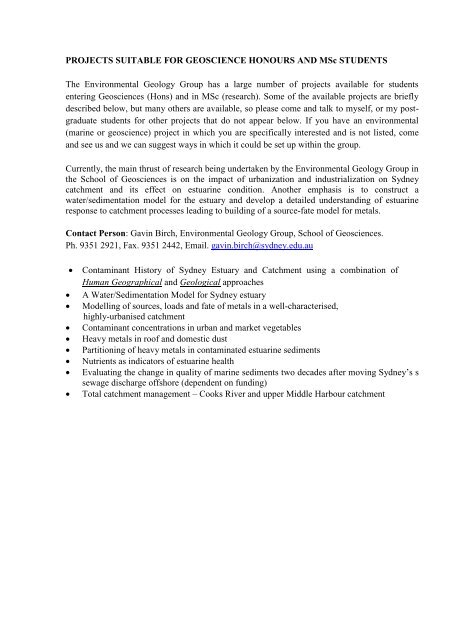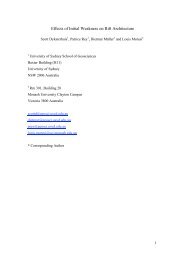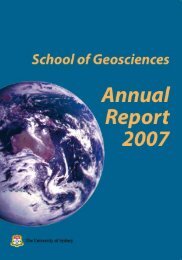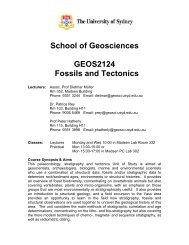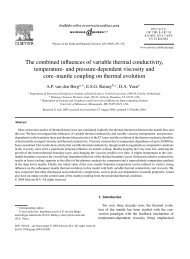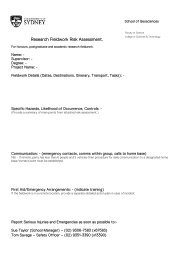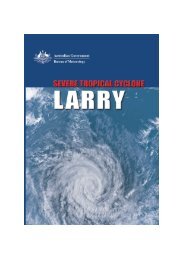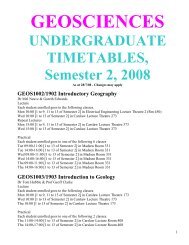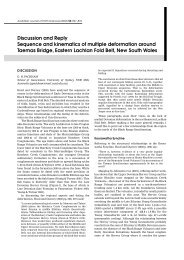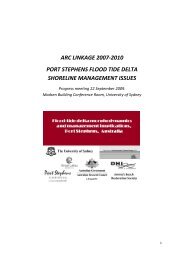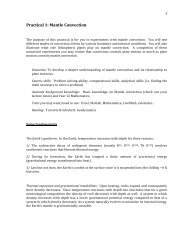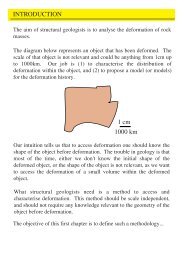Gavin Birch - School of Geosciences
Gavin Birch - School of Geosciences
Gavin Birch - School of Geosciences
You also want an ePaper? Increase the reach of your titles
YUMPU automatically turns print PDFs into web optimized ePapers that Google loves.
PROJECTS SUITABLE FOR GEOSCIENCE HONOURS AND MSc STUDENTS<br />
The Environmental Geology Group has a large number <strong>of</strong> projects available for students<br />
entering <strong>Geosciences</strong> (Hons) and in MSc (research). Some <strong>of</strong> the available projects are briefly<br />
described below, but many others are available, so please come and talk to myself, or my postgraduate<br />
students for other projects that do not appear below. If you have an environmental<br />
(marine or geoscience) project in which you are specifically interested and is not listed, come<br />
and see us and we can suggest ways in which it could be set up within the group.<br />
Currently, the main thrust <strong>of</strong> research being undertaken by the Environmental Geology Group in<br />
the <strong>School</strong> <strong>of</strong> <strong>Geosciences</strong> is on the impact <strong>of</strong> urbanization and industrialization on Sydney<br />
catchment and its effect on estuarine condition. Another emphasis is to construct a<br />
water/sedimentation model for the estuary and develop a detailed understanding <strong>of</strong> estuarine<br />
response to catchment processes leading to building <strong>of</strong> a source-fate model for metals.<br />
Contact Person: <strong>Gavin</strong> <strong>Birch</strong>, Environmental Geology Group, <strong>School</strong> <strong>of</strong> <strong>Geosciences</strong>.<br />
Ph. 9351 2921, Fax. 9351 2442, Email. gavin.birch@sydney.edu.au<br />
<br />
<br />
<br />
<br />
<br />
<br />
<br />
<br />
<br />
Contaminant History <strong>of</strong> Sydney Estuary and Catchment using a combination <strong>of</strong><br />
Human Geographical and Geological approaches<br />
A Water/Sedimentation Model for Sydney estuary<br />
Modelling <strong>of</strong> sources, loads and fate <strong>of</strong> metals in a well-characterised,<br />
highly-urbanised catchment<br />
Contaminant concentrations in urban and market vegetables<br />
Heavy metals in ro<strong>of</strong> and domestic dust<br />
Partitioning <strong>of</strong> heavy metals in contaminated estuarine sediments<br />
Nutrients as indicators <strong>of</strong> estuarine health<br />
Evaluating the change in quality <strong>of</strong> marine sediments two decades after moving Sydney’s s<br />
sewage discharge <strong>of</strong>fshore (dependent on funding)<br />
Total catchment management – Cooks River and upper Middle Harbour catchment
An investigation <strong>of</strong> the effects <strong>of</strong> historic changes in catchment<br />
condition on the health <strong>of</strong> Sydney Estuary<br />
Supervisors: <strong>Gavin</strong> <strong>Birch</strong>, Philip McManus and Andrew Wilson<br />
<br />
<br />
<br />
<br />
Objectives:<br />
The overall aim <strong>of</strong> this project is to determine how temporal changes in catchment status<br />
controls estuarine condition.<br />
This project will investigate Sydney Estuary as a considerable amount <strong>of</strong> data is available<br />
for this catchment-estuary system and substantial temporal change has been demonstrated<br />
for both environments. The project will record the development <strong>of</strong> the nation’s first and<br />
largest city and its effect in the iconic Sydney Harbour and will include the following:<br />
Create a spatial time series <strong>of</strong> catchment status and estuarine condition from 1788 to<br />
2010 using GIS-based historic landuse maps and dated sedimentary cores.<br />
Model historic environmental impact on Sydney Harbour<br />
Use hindsight information on impact to model future environmental trends<br />
Identify key pressure indicators driving changes in estuarine response for use in<br />
development <strong>of</strong> future strategies in urban Management and Planning.<br />
This project fits neatly within the <strong>School</strong> <strong>of</strong> <strong>Geosciences</strong> ambit as it combines Human<br />
Geography and Geoscience parts <strong>of</strong> the <strong>School</strong>. The work would suit students from both<br />
disciplines and comes with strong supervision in estuarine science (<strong>Gavin</strong>), urban<br />
geography (Philip) and spatial (GIS) science (Andrew). The shorelines <strong>of</strong> Port Jackson<br />
have been extensively reclaimed and previous work done by this Group has shown that<br />
this process has had a considerable impact on quality <strong>of</strong> the adjacent estuarine<br />
environment. We need to extend this work to determine the effects <strong>of</strong> urbanization and<br />
industrialization <strong>of</strong> the catchment on the condition <strong>of</strong> the estuary. The project involves<br />
mapping the development <strong>of</strong> urbanisation and industry in the catchment <strong>of</strong> Sydney<br />
Harbour using historic records/maps and GIS. Sediment adjacent to industrial sites will be<br />
cored for evidence <strong>of</strong> impact. Removal <strong>of</strong> industry from the catchment, so prominent in<br />
the last 10 years, will also be documented. This ‘rise and fall’ <strong>of</strong> industry in Sydney will<br />
be related to temporal impact as detected in dated sedimentary cores from the estuary.<br />
Different vintages <strong>of</strong> chemical data for harbour sediments will be entered into the GIS<br />
database and related to changes in the development <strong>of</strong> the catchment.<br />
Recent (2011) data indicate that the status <strong>of</strong> Sydney estuary is improving. This project<br />
sets out to determine why and how estuarine condition deteriorated and is now recovering<br />
and use this valuable information to suggest how we should proceed in future urban<br />
planning, not only for Sydney, but other heavily impacted estuaries.
This project has the enormous potential for popularisation through publication (book) and<br />
TV<br />
A water and sedimentation model for Sydney estuary<br />
Supervisors: <strong>Gavin</strong> <strong>Birch</strong> and Guillaume Duclaux (CSIRO)<br />
Objectives:<br />
Determining the amount <strong>of</strong> stormwater available within the Sydney estuary catchment<br />
for water harvesting<br />
Determining erosion rates and mass <strong>of</strong> contaminants exported to Sydney estuary<br />
Determining sedimentation rates in Sydney estuary<br />
Construct a sedimentation model for Sydney estuary based on the new ‘Tellus’<br />
CSIRO-supported 3D-parallel code<br />
Background: Water resources have, belatedly, come to be realised as Australia’s most<br />
precious (and wasted) resource. This is not restricted to a rural/agricultural problem.<br />
Combined reservoirs serving Sydney were (September 2007) at a historical minimum, i.e.<br />
at 34% capacity. Sedimentation in Port Jackson is <strong>of</strong> vital importance to the management<br />
<strong>of</strong> the estuary. High sedimentation rates affect seagrass growth, smother fringe populations<br />
and prevent vessels from using large valuable marine facilities. Sediment, especially the<br />
finer fraction, is the major carrier <strong>of</strong> contaminants and in some parts <strong>of</strong> Port Jackson<br />
sediment contains concentrations <strong>of</strong> some chemicals that are adversely effecting benthic<br />
populations.<br />
Yet to date no water budget is available for Port Jackson catchment and little is known<br />
about sedimentation rates in the estuary. Currently, an unknown quantity <strong>of</strong> re-useable<br />
stormwater is being discharges into Port Jackson and there are no plans for harvesting<br />
such resources. There is a desperate need to improve the quality <strong>of</strong> some surficial sediment<br />
in Port Jackson so that benthic populations can be re-established and yet there is no<br />
consideration on how this can be achieved. A very expensive (>$1m) program has been<br />
ongoing in Sydney for a considerable period to prevent sediment leaving construction sites<br />
without the success <strong>of</strong> the venture being evaluated.<br />
The Project: The project aims to produce a run<strong>of</strong>f and sedimentation model for Port<br />
Jackson using data already acquired by the Environmental Geology Group. The<br />
environmental status <strong>of</strong> canals and creeks currently discharging to the Sydney estuary will<br />
be assessed and categorised to assist in management <strong>of</strong> these valuable resources.<br />
Theoretical water run<strong>of</strong>f and soil erosion/transportation models will use digital evaluation<br />
models, landuse, impervious surface data and rainfall information. Data outputs will be
introduced into ‘Tellus’ a new CSIRO-supported 3D-parallel code based on particle-incell<br />
technique capable <strong>of</strong> simulating geomorphic evolution. Tellus solves the shallow<br />
water equation to simulate various types <strong>of</strong> flow on an unstructured grid. External forces<br />
such as sea-level fluctuation, vertical displacement, rainfall and river inflows can be<br />
imposed. A sediment transport criterion allows siliciclastic material to be eroded,<br />
transported and deposited. The code is capable <strong>of</strong> modelling compaction based on<br />
sediment loading. Model outputs will be compared to flow rates, sedimentation rates and<br />
temporal changes in bathymetry in the estuary.<br />
The second part <strong>of</strong> the project will include a detailed critique <strong>of</strong> water use in the catchment<br />
and how stormwater can be harvested to provide a valuable in situ resource for domestic<br />
use and recreational areas in some <strong>of</strong> the most densely urbanised areas <strong>of</strong> the city. This<br />
will link elegantly with a current PhD project which is aiming to optimise the efficiency <strong>of</strong><br />
a filtration device to remediate stormwater discharging into the estuary. Storage <strong>of</strong><br />
stormwater is an issue and there is a need to think ‘outside the square’. Can the (porous)<br />
Hawkesbury Sandstone underlying the city be used for storage, or can the Sydney storage<br />
tunnel be utilised for short term benefits? On-the-ground work will be undertaken to<br />
determine actual mass <strong>of</strong> sediment leaving a number <strong>of</strong> better known catchments and these<br />
data will be related to modelled information and sedimentation rates as determined from<br />
the receiving basin. Then theoretical sedimentation model may have to be calibrated for<br />
the Sydney estuary and catchment. We have already determined metal concentrations <strong>of</strong><br />
soil in the entire Sydney estuary catchment and now we need to know how or if this<br />
material is being exported to the estuary. If soil is being delivered to the harbour in large<br />
amounts, is there a need to remove contaminated sediment from the estuary? If so, how<br />
should this be undertaken? Dredging is an option, but why is it not being considered?<br />
This project will be integrated with other work being undertaken within the <strong>School</strong>, i.e.<br />
modelling catchment contaminant loading, stormwater run<strong>of</strong>f studies, stormwater<br />
remediation and building a science-based strategy for the long-term management <strong>of</strong> the<br />
harbour.<br />
Modelling <strong>of</strong> sources, loads and fate <strong>of</strong> metals in a well-characterised, highlyurbanised<br />
catchment<br />
Supervisor: <strong>Gavin</strong> <strong>Birch</strong><br />
Objectives:<br />
Determine and quantify primary sources <strong>of</strong> metal contamination in a well<br />
characterised catchment (Iron Cove)<br />
Establish source and magnitude <strong>of</strong> vehicular contributions <strong>of</strong> metals to run<strong>of</strong>f<br />
Investigate generation <strong>of</strong> ‘new’ metals by residential landuse
Quantify atmospheric metals deposition<br />
Build integrated source-fate model for catchment<br />
Assess best management practise for stormwater harvesting and reuse<br />
Urban stormwater is commonly contaminated with high concentrations <strong>of</strong> contaminants,<br />
including metals. These toxicants are a threat to the health <strong>of</strong> our aquatic ecosystems and<br />
recent work has shown that 60% <strong>of</strong> streams in the USA and 30% in New Zealand contain<br />
concentrations in excess <strong>of</strong> guidelines.<br />
A considerable amount <strong>of</strong> data exists for a catchment-estuary ecosystem in Sydney estuary<br />
(Iron Cove), which provides, for the first time, the opportunity <strong>of</strong> establishing a verified,<br />
well-documented, integrated source-fate model for metals in a highly-urbanised<br />
catchment. The large amount <strong>of</strong> data collected in this coupled system has lead to a general<br />
assumption <strong>of</strong> the primary sources <strong>of</strong> these chemicals however, there have been few<br />
attempts to either confirm these sources or determine the relative contributions from each<br />
source. The main reason for this is that such investigations require accurate estimates <strong>of</strong><br />
the chemical loads contributed by each <strong>of</strong> the individual sources and <strong>of</strong> the total loads<br />
draining from the catchments containing the sources. These load estimates may be<br />
obtained with sufficient accuracy only from intensive monitoring and modelling <strong>of</strong><br />
stormwater quality and quantity for each individual source, as well as for the catchment<br />
containing the sources. Monitoring and modelling programmes on this scale are very<br />
expensive. At Sydney University we have now reached a situation where separate studies<br />
together provide most <strong>of</strong> the data required to enable metal sources in urban catchments to<br />
be identified and quantified.<br />
Existing treatment technologies such as wetlands and swales may fail to effectively<br />
remove soluble pollutants, which are generally considered the most toxic component. In<br />
addition, there is typically limited available open space in the densely populated urban<br />
areas where heavy metal and hydrocarbon pollution is prevalent, precluding the use <strong>of</strong><br />
wetlands and/or swales for treatment <strong>of</strong> stormwater.<br />
The present study therefore focuses on identifying and quantifying urban metal sources<br />
and developing a deep understanding <strong>of</strong> catchment processes sources and establishing best<br />
management practise for this catchment-estuary system<br />
Contaminant concentrations in urban and market vegetables<br />
Supervisor: <strong>Gavin</strong> <strong>Birch</strong>
Objectives:<br />
<br />
<br />
<br />
<br />
Determine concentration <strong>of</strong> metals in vegetables grown in urban settings<br />
Compare metal concentrations <strong>of</strong> urban and market vegetables<br />
Relate tissue concentrations to health guidelines<br />
Model human uptake potential<br />
An increasing number <strong>of</strong> vegetable gardens are being constructed in urban settings,<br />
especially in areas such as Sydney. Metal atmospheric deposition models developed by<br />
USEEG show that a significant mass <strong>of</strong> contaminants is settling in extensive parts <strong>of</strong><br />
metropolitan Sydney. No information currently exists in relation to the concentration <strong>of</strong><br />
metals in urban vegetable soils or in the tissue <strong>of</strong> plants being grown in these soils. It is<br />
therefore important to determine the processes governing the uptake <strong>of</strong> metals by plants<br />
being increasingly grown in these settings.<br />
Large capital cities, such as Sydney, are rapidly expanding into areas traditionally used for<br />
market gardening. With urban expansion comes increased road infrastructure and<br />
industrialisation which in turn elevates the production and deposition <strong>of</strong> heavy metals.<br />
Soils in these areas are expected to have increasing concentrations <strong>of</strong> heavy metals.<br />
Currently, there is no information as to the changing nature <strong>of</strong> these soils, nor are there<br />
any data on possible increasing metal concentrations in vegetables that have been grown in<br />
these areas.<br />
Heavy metals in ro<strong>of</strong> and domestic dust<br />
Supervisor: <strong>Gavin</strong> <strong>Birch</strong><br />
Objectives<br />
Estimate contribution by atmospheric processes<br />
Relate ro<strong>of</strong> dust to existing metal model <strong>of</strong> atmospheric contributions<br />
Estimate <strong>of</strong> contaminant loading over time<br />
Biomonitor atmospheric conditions within domestic homes<br />
Provide important information for determining methods for source control and<br />
remediation.<br />
A pilot study undertaken by an Honours student in 2004 has shown that ro<strong>of</strong> dust is highly<br />
contaminated by a wide range <strong>of</strong> heavy metals. Ro<strong>of</strong> dust provides an estimate <strong>of</strong> the
contribution by atmospheric processes <strong>of</strong> heavy metal emissions from a variety <strong>of</strong> sources,<br />
e.g. vehicles, industry, incineration, etc. Information from ro<strong>of</strong> dust will be related to<br />
metal modelling <strong>of</strong> atmospheric contributions undertaken in 2004, as well as to data now<br />
being generated on soil chemistry in the Port Jackson catchment. Ro<strong>of</strong> dust also provides<br />
an estimate <strong>of</strong> contaminant loading over time, which will be very useful as input<br />
parameters for catchment modelling now being carried out within the Group.<br />
Domestic dust is a useful biomonitor <strong>of</strong> atmospheric conditions within domestic homes, as<br />
well as other premises e.g. working environment. It is therefore a method <strong>of</strong> assessing the<br />
potential threat facing humans within their homes and places <strong>of</strong> work. The origin <strong>of</strong> these<br />
contaminants will provide important information for determining methods for source<br />
control and remediation.<br />
Partitioning <strong>of</strong> heavy metals in contaminated estuarine sediments<br />
Supervisor: <strong>Gavin</strong> <strong>Birch</strong><br />
Objectives<br />
<br />
<br />
<br />
<br />
Determine major phases with which the contaminants are associated<br />
Establish processes controlling metal bioavailability<br />
Characterize the chemical composition <strong>of</strong> pore water<br />
Investigate improved sediment quality assessment techniques<br />
A deeper understanding <strong>of</strong> the effects <strong>of</strong> contaminants can be gleaned by determining the<br />
major phases with which the contaminants are associated. There are many selective and<br />
sequential extraction methodologies which can provide such information, but after some<br />
experimentation in conjunction with other groups, one technique is being used by this<br />
Group. This information can be augmented by undertaking further extraction procedures<br />
with different mixtures and concentrations <strong>of</strong> acids and chelating agents. The dominance<br />
<strong>of</strong> sediment sulphides in controlling metal bioavailability is well recognised for some<br />
sediments. Sulphides can complex with metal ions to form water-insoluble precipitates<br />
and it is the extent to which this sulphide component is soluble in cold acid that is<br />
important in controlling toxicity <strong>of</strong> some heavy metals. This so called ‘AVS’ technique<br />
needs to be tested against other methods. Another common approach is to characterize the<br />
chemical composition <strong>of</strong> pore water. The assumption here is that it is the nature <strong>of</strong> the<br />
interstitial fluids that is important in the uptake by infauna. Again there are several<br />
methods by which the chemistry <strong>of</strong> the pore waters can be determined, including removal<br />
<strong>of</strong> the sediment and centrifugation, in situ diffusion, or filtration techniques, etc. and some<br />
<strong>of</strong> these will be attempted. Several other techniques for assessing sediment quality<br />
currently in use should be tested, including SEM, EDAX techniques, equilibrium<br />
partitioning, etc.
Ultimately, the optimum approach is to express contaminant concentrations as a function<br />
<strong>of</strong> the capacity <strong>of</strong> the sediment to bind them. This involves the size, mineralogy and<br />
chemistry <strong>of</strong> the sediment, as well as the physio-chemical characteristics <strong>of</strong> the ambient<br />
sediment. This is a complex area <strong>of</strong> environmental science, but it is one <strong>of</strong> the most<br />
important problems which need to be dealt with urgently, and it is one for which there may<br />
not be a unique solution. The results <strong>of</strong> this study will hopefully lead to an improved<br />
sediment quality assessment technique.<br />
Any mutually agreed environmental (marine and geoscience) topic


